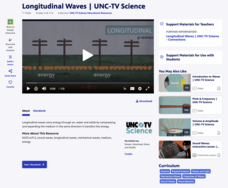PBS
Longitudinal Waves | UNC-TV Science
Discover whether sound travels in space and other fascinating science facts. Scientists explore energy transfer by longitudinal waves and learn about compression, rarefaction, amplitude, and wavelength while watching an animated video....
Physics Girl
I Built an Acoustic Levitator! Making Liquid Float on Air
Think of current acoustic levitator technology as a hover board for tiny things! Introduce young physicists to this emerging gadget using a video from an informative playlist touching on physics topics. Viewers watch as Physics Girl and...
Veritasium
The Brightest Part of a Shadow Is in the Middle
Shed some light on the nature of shadows! Science sleuths investigate a 200-year-old theory that light will form a bright spot in the center of a sphere's or circle's shadow with a video from Veritasium. The resource explains the...
Bozeman Science
PS4A - Wave Properties
Does your lesson plan for wave properties have its ups and downs? Get some fresh ideas from an informative video! The narrator discusses PS4A, showing the must-know ideas for each grade level through concept maps and demonstrations.
MinutePhysics
What is the Wave/Particle Duality? Part 1
Einstein rejected the idea of wave/particle duality, yet now we believe the concept to be true. A short video explains the properties of waves, particles, and the behavior of electrons, which act as both. The film concludes with...
MinutePhysics
What is the Wave/Particle Duality? Part 2
Electrons, neutrons, and photons display behavior explained by wave-particle duality. The video explains how to picture the duality of behaviors in these parts of atoms. The drawings and comparisons to the behavior of water focus on...
Bozeman Science
Waves
Calculating frequency is so easy it Hertz! The video begins by describing transverse and longitudinal waves, and then it explores their properties and applications. Finally, it applies this to the formulaic relationships between wave...
Flipping Physics
AP Physics 1: Mechanical Waves Review
Ride the wave to a successful exam! Review everything AP Physics pupils will need to know about mechanical waves for the AP exam with a concise, engaging, and accurate video. A wonderful way to review before the...
TED-Ed
The Sonic Boom Problem
Sound waves travel pretty quickly, but humans can travel faster. Follow along with this short animated video as it investigates the physics behind the breaking of the sound barrier and the sonic booms that are...
TED-Ed
Why Do Buildings Fall in Earthquakes?
There are few natural phenomena as startling as an earthquake, and depending on the building you're in, these experiences can be downright terrifying. Follow along as this video explores the factors that determine how a building...
TED-Ed
How Does Your Smartphone Know Your Location?
When your smartphone tells you the weather of your current location or gives you directions to the nearest gas station, there's more going on that you might realize. Follow along with this short video as it explains how...
TED-Ed
What is the Heisenberg Uncertainty Principle?
Not sure how to introduce young physicists to the Heisenberg Uncertainty Principal? Well this short video is a great place to start, as it explains how the particle and wave nature of matter makes it impossible to know both the...
TED-Ed
Schrödinger's Cat: A Thought Experiment in Quantum Mechanics
Can something be both alive and dead at the same time? According to quantum physicist Erwin Schrödinger, the answer is yes. Watch this short video to learn how the wave and particle nature of all matter allows objects to be in two states...












